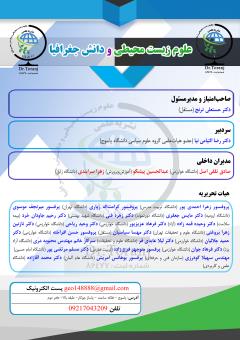عوامل فرهنگی مؤثر بر فرزند آوری زنان تحصیلکرده و عادی در شهر یاسوج
محورهای موضوعی : social Sciencesمریم عزیزی 1 , ساعد حیدرپور 2 , مینا هلالی ستوده 3
1 - دانشگاه کاشان
2 - دانشگاه کاشان
3 - دانشگاه اصفهان
کلید واژه: تمایلات فرزند آوری, مذهب, استقلال زنان, فرزندان در قید حیات, تحصیلکرده ,
چکیده مقاله :
با توجه به شرایط باروری ایران در طول سه دههی گذشته، تدوین و اجرای موفق هرگونه سیاست جمعیتی، متکی به ارتقای شناخت ما از رفتارها، ترجیحات و تمایلات فرزند آوری زوجین، عوامل مؤثر بر تمایلات فرزند آوری آنها، و شناسایی زیرگروههای جمعیتی دارای تمایلات فرزند آوری پایین و بسیار پایین است. هدف از این پژوهش بررسی عوامل مؤثر بر تمایلات فرزند آوری زنان تحصیلکرده ساکن در شهر یاسوج است. دادهها حاصل پیمایشی است که در زمستان 1401 در میان ۵۰۰ خانوار نمونهی شهر یاسوج صورت گرفته است. روش نمونهگیری روش خوشهای چندمرحلهای است. نتایج نشان داد که ۴۴ درصد از زنان در مقابل ۴۰ درصد زنان تحصیلکرده اظهار داشتهاند که علاوه بر فرزندانی که در زمان تحقیق داشتهاند، تمایل به داشتن فرزند دیگر دارند. از میان زنان تحصیلکرده که تمایل به فرزند آوری داشتند، ۶۲ درصد آنها ۱ فرزند دیگر و تنها۳ درصد از آنها ۳ فرزند دیگر و بیشتر میخواهند. نسبتهای متناظر برای زنان به ترتیب4/66 درصد و8/1درصد میباشد. نتایج تحلیل دومتغیره نشان داد که رابطهی معنیداری بین پایگاه اقتصادی - اجتماعی، استفاده از وسایل ارتباطجمعی، استقلال زنان، سن ازدواج و شمار فرزندان در قید حیات و تمایلات فرزند آوری زنان وجود دارد. نتایج تحلیل چند متغیره بیانگر این واقعیت است که مشخصههای اقتصادی - اجتماعی بهتنهایی نمیتوانند نقش تعیینکنندهای در پیشبینی احتمال تمایل داشتن به فرزند آوری داشته باشند. درواقع ترکیبی از مشخصههای اقتصادی _ اجتماعی، فرهنگی و جمعیتی تبیین بهتری از تمایلات فرزند آوری زنان تحصیلکرده به دست میدهد (59/9درصد در مقابل4/67درصد).
Considering the fertility conditions of Iran during the last three decades, the formulation and successful implementation of any population policy relies on improving our understanding of the behaviors, preferences and desires of couples to have children, the factors affecting their desires to have children, and the identification of demographic subgroups with the desire to have children. The yield is low and very low. The purpose of this research is to investigate the factors affecting the desire to have children of educated women living in Yasouj city. The data is the result of a survey that took place in the winter of 1401 among 500 sample households in Yasouj city. The sampling method is a multi-stage cluster method. The results showed that 44% of women compared to 40% of educated women stated that they would like to have another child in addition to the children they had at the time of the research. Among the educated women who wanted to have children, 62% of them want 1 more child and only 3% of them want 3 more children. The corresponding ratios for women are 66.4% and 1.8%, respectively. The results of the bivariate analysis showed that there is a significant relationship between the socio-economic base, the use of mass communication tools, women's independence, age at marriage, and the number of children alive and women's desire to have children. The results of multivariate analysis show the fact that socio-economic characteristics alone cannot play a decisive role in predicting the probability of wanting to have children. In fact, a combination of socio-economic, cultural and demographic characteristics gives a better explanation of educated women's desire to have children (9.59% versus 67.4%).
• عباسی شوازی، محمدجلال(1380). "همگرایی رفتارهای باروری در ایران، میزان، روند والگوی سنی باروری در استانهای کشور در سالهای1351و1375"، نامهی علوم اجتماعی، شمارهی 18، صص231-201.
• عباسی شوازی، محمد جلال و دیگران(1381)."بررسی دیدگاه زنان در مورد رفتارهای باروری در استان یزد با استفاده از روشهای کیفی"،نامهی علوم اجتماعی، شمارهی 20، صص75-25.
• حسینی، حاتم(1387). "قومیت و باروری: تبیین رفتارهای باروری زنان کرد و ترک در شهرستان ارومیه"، رسالهی دکترای جمعیتشناسی، دانشکدهی علوم اجتماعی، دانشگاه تهران.
• حسینی، حاتم(1390). جمعیتشناسی اقتصادی اجتماعی و تنظیم خانواده، همدان: انتشارات دانشگاه بوعلی سینا، چاپ چهارم.
• زنجانی، حبیبالله، محمد میرزایی،امیر هوشنگ مهریار و کامل شادپور(1378). جمعیت، توسعه و بهداشت باروری، تهران: نشرنی.
• سرایی، حسن(1376). "مرحلهی اول گذار جمعیتی ایران"،نامهی علوم اجتماعی، شمارهی 9و10، صص51-67.
• نورالله زاده، عسکر(1392). بررسی رفتار تمایلات و ایدئالهای باروری زنان ازدواجکردهی 49-15 سالهی شهر دهلران، پایاننامهی کارشناسی ارشد، دانشکدهی اقتصاد و علوم اجتماعی، دانشگاه بوعلی سینا.
• کلانتری، صمد، ربانی، رسول و رزیتا اکتابی(1385)."بررسی عوامل اجتماعی، اقتصادی و فرهنگی تأثیرگذار بر میزان باروری با تأکید بر نقش تنظیم خانواده در شهر اصفهان"،فصلنامهی علمی-پژوهشی دانشگاه آزاد اسلامی-واحد شوشتر، سال اول، پیششمارهی اول، پاییز1385،صص150-107.
• Bhende, A.A., and T, Kanitkar. (1994). Principles of Population studies, Sixth, Revised Edition, Himalaya Publishing Hose.
• Robinson, W. C. (1997). The economic theory of fertility over three decades.Population studies, 51(1), 63-74.
• Weeks, John R (1999). population An international to concept and Issue. California, wads worth.
• Bongaarts, J. (1993). The supply-demand framework for the determinants of fertility: An alternative implementation. Population studies, 47(3), 437-456.
• Wilson, C (2001). Implications of Global Demographic Convergence for Fertility Theory:, Paper Presented at IUSSP Confernece on: Low Fertility in Advanced Countries L Trends, Theories and Policies, 21-23.
• Sorenson, A. M. (1985). Fertility Expectations and Ethnic Identity among Mexican-American Adolescents An Expression of Cultural Ideals. Sociological Perspectives, 28(3), 339-360.
• Lesthaeghe, R., & Surkyn, J. (1988). Cultural dynamics and economic theories of fertility change. Population and development review, 14(1), 1-45. Lesthaeghe, R., & Wilson, C. (1986). Modes of production secularization and the pace of the fertility decline in Western Europe 1870-1930.
• Hirschman, C. (1994). Why fertility changes. Annual review of sociology, 203-233.
• Karter, A. T. (1998). Cultural Models and Demographic Behavior. In Basu, A. M. and Abby, P. (Eds.) The Methods and Uses of Anthropological Demography Oxford: Oxford University Press, 246 – 267.
• Van de Kaa, D. J. (2001). Postmodern fertility preferences: from changing value orientation to new behavior. Population and Development Review, 290-331.


